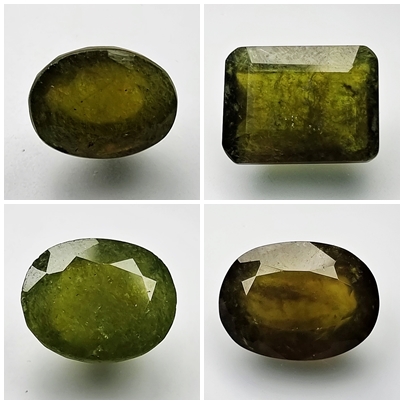Vesuvianite: Gemstones Information
Vesuvianite, also known as idocrase, is a fascinating mineral with a range of beneficial properties and applications. Let’s explore the information and potential advantages of vesuvianite:
Physical Characteristics: Vesuvianite is a calcium magnesium aluminum silicate mineral with the chemical formula Ca10(Mg,Fe)2Al4(SiO4)5(Si2O7)2(OH,F)4. It typically occurs in shades of green, yellowish-green, brown, or reddish-brown, although it can also exhibit other colors such as blue, purple, or colorless. Vesuvianite crystals often form prismatic or wedge-shaped structures, and they may display a vitreous to resinous luster.
Occurrence: Vesuvianite is found in various geological environments, including metamorphic rocks such as marble, schist, and skarn, as well as in some igneous rocks like granite and syenite. Significant deposits of vesuvianite have been discovered in locations around the world, including Italy (where it was first discovered near Mount Vesuvius, hence the name), Canada, the United States, Switzerland, and Russia.
Healing and Metaphysical Properties: In metaphysical and holistic healing practices, vesuvianite is believed to possess a range of beneficial properties. It is often associated with promoting feelings of well-being, harmony, and inner peace. Vesuvianite is said to stimulate creativity, enhance intuition, and encourage spiritual growth. Additionally, it is thought to support physical healing processes, particularly those related to the nervous system, digestion, and detoxification.
Jewelry and Ornamental Use: Vesuvianite’s attractive colors and unique properties make it a popular choice for jewelry and ornamental purposes. Gem-quality vesuvianite, particularly specimens with intense green or bluish-green hues, can be cut and polished into faceted gemstones for use in rings, earrings, pendants, and other jewelry pieces. The stone’s durability and relatively high hardness (around 6.5 on the Mohs scale) make it suitable for use in various types of jewelry settings.
Collectibility: Fine specimens of vesuvianite, especially those with vivid coloration, clarity, and well-defined crystal forms, are highly sought after by mineral collectors and enthusiasts. Collectors value vesuvianite for its rarity, aesthetic appeal, and the diversity of colors and crystal habits it exhibits. High-quality specimens may command significant prices in the mineral market, particularly if they come from renowned localities or exhibit exceptional characteristics.
Geological Significance: Vesuvianite’s occurrence in specific geological settings provides valuable insights into the processes of metamorphism and hydrothermal alteration. Studying vesuvianite-bearing rocks helps geologists understand the conditions under which these minerals form and the geological history of the regions where they are found. Vesuvianite may also serve as an indicator mineral for certain types of mineral deposits, aiding in mineral exploration efforts.
Industrial Applications: While vesuvianite is primarily valued for its aesthetic and metaphysical properties, it also has some industrial applications. In certain industries, vesuvianite may be used as a raw material for manufacturing ceramic products, refractories, and abrasives. However, these applications are relatively limited compared to its use in jewelry and ornamental objects.
In summary, vesuvianite is a versatile and intriguing mineral with a range of beneficial properties and applications. Whether appreciated for its healing properties, used in jewelry and ornamental objects, or collected for its geological significance, vesuvianite continues to captivate individuals around the world with its natural beauty and diverse characteristics.





